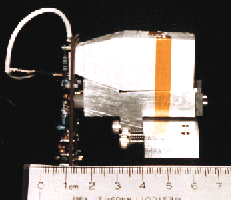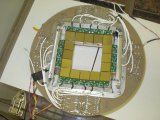What is a forward array?
A forward array is a group of detectors that cover the forward (in front of target) angles, while a backward array would cover the rear (behind target) angles. A 4π detector covers all angles around the target.
Why use a forward array?
- Why would you want a forward array, instead of a 4π array? There are two main reasons:
-
- Physics
-
- The type of reactions being studied dictate what apparatus would be best for the job. Forward arrays are good for looking at the quasiprojectile (projectile like) fragments from a reaction, which have high velocity, and hince energy, than midperipheral or neck (mixture of projectile/target) fragments and quasitarget (target like) fragments. The higher energy allows for increased thresholds, allowing higher resolution out of the detectors. A 4π array, requires low threshold detectors, because you want to collect all fragments from the reaction, but the resolution is not as good.
Forward arrays are good for peripheral collisions, that is collisions where the target and projectile just slightly overlap. 4π arrays are good for central collisions, where the target and projectile collide head on. For the inbetween central and peripheral collisions (mid peripheral collisions), the type of array depends on what you want to study.
-
- Construction
- A forward array is cheaper than a 4π array, and it is very difficult to design a 4π array that has very high anglular coverage.
- Physics
How is FAUST constructed?
- FAUST is a forwad array that is composed of 68 detector telescopes housed in five rings (Figure 1). FAUST has solid angle coverage of 90% from 2.3º to 33.6°, 71% from 1.6º to 2.3°, and 24.9% from 33.6º to 44.8º. Ring A covers 1.64º to 6.36º and has 8 telescopes, ring B covers 4.60º to 12.28º and has 12 telescopes, rings C, D and E cover 8.84º to 19.73º, 14.30º to 30.77º and 22.63º to 44.85º, respectively and each contain 16 telescopes. Ring C is shown in Figure 2.
Figure 1. Left side: Faust angular distribution of rings. Right side: FAUST as viewed by an incoming particle.


How is each telescope constructed?
-
- Each telescope has an edge mounted 300 μm (micrometer) silicon detector model MSI-MSX04-300, manufactured by
-
- , followed by a 3 cm (centimeter) CsI(Tl) crystal, manufactured by
Bicron (now Saint-Gobain Crystals & Detectors)
-
- , whose light output is focused on a model S5107 photodiode, manufactured by
- , using a lucite light-guide all shown below.
Figure 3. From left to right: A prototype FAUST telescope assembled, the 300 μm silicon detector, the CsI, Lucite light guide, photodiode and phosphor (used to align the beam to target position).

![]()

